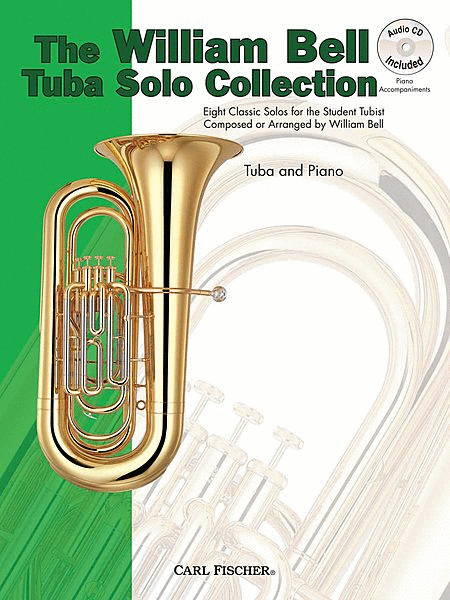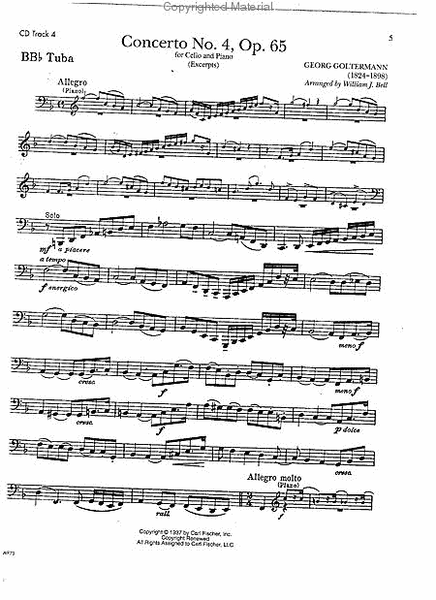The William Bell Tuba Solo Collection
Eight Classic Solos for the Student Tubist Composed or Arranged by William Bell
-
Ships in 1 to 2 weeks
Details
Description
SKU: CF.WF79
Eight Classic Solos for the Student Tubist Composed or Arranged by William Bell. Composed by George Frideric Handel, Johann Sebastian Bach, Ludwig van Beethoven, Robert Schumann, and William Bell. Edited by William Bell. Arranged by William Bell. SWS. Collection. With Standard notation. 48+16 pages. Carl Fischer Music #WF79. Published by Carl Fischer Music (CF.WF79).UPC: 798408068219. 9 X 12 inches.
This edition is a unique collection of eight well-known solos for tuba and piano by oneof the premier American tuba players and teachers of the twentieth century. Throughouthis long and illustrious career, William J. Bell composed and arranged numerous piecesfor tuba and piano accompaniment often with a pedagogic purpose in mind.This collection features four of Bell’s compositions that are often witty and, of course,all idiomatically written for the tuba. The four arrangements cover the Baroque period(Bach), the Classical period (Beethoven) and the Romantic period (Schumann andGoltermann) providing a varied span of styles.Included in this publication are downloadable audio files of the piano accompaniments— a practical solution for the practice of these pieces and an enjoyable incentive.
William John Bell was and is still considered to be one of the premier American tuba playersand teachers of the twentieth century. He was born in 1902 to non-musical parents in Creston, Iowa. Atthe age of ten, Bell began playing the tuba—the exact circumstances for his choice of this instrumenttuba remain unknown—in a local amateur band composed primarily of young boys. He progressed sorapidly on the instrument that he was invited to tour with a professional band at the age of fourteenand continued touring at age fifteen, after he was accepted on full scholarship at the University ofSouth Dakota.His notoriety as a tuba virtuoso spread rapidly, such that in 1921, at the tender age of nineteen,Bell joined John Philip Sousa’s band; Sousa, in fact, accepted Bell without an audition. In 1923, theconductor Fritz Reiner invited Bell to serve as the principal tuba player of the Cincinnati SymphonyOrchestra. He held this position until 1937, while simultaneously teaching tuba performance at theCincinnati Conservatory of Music. During these years, he made occasional appearances in EdwinFranko Goldman’s band in New York City and Arthur Pryor’s Asbury Park Municipal Band.In 1937, Bell was selected by Arturo Toscanini to be the principal tuba player of the newlyformed NBC Symphony Orchestra. Bell, in fact, was the third musician to be selected, following theconcertmaster and the principal oboist, and Toscanini, renowned for his belittlement of professionalorchestral players, repeatedly extolled the virtues of Bell’s playing. Six years later, Bell became theprincipal tuba player of the New York Philharmonic. In 1955, Bell presented the American premiere ofRalph Vaughan Williams’ Concerto for Bass Tuba and Orchestra at the composer’s request. Bell spentthe final decade of his life as professor of tuba performance at Indiana University, resigning from thispost in the year of his death in 1971.Bell’s significance in American tuba playing and pedagogy can be seen in the tribute that ispaid to him each Christmas—he was born on Christmas day in 1902—at the “TubaChristmas” event.Founded in 1974 by his pupil Harvey Phillips, the event features hundreds of tuba and euphoniumplayers from around the world who gather to commemorate the Bell’s achievement.Bell composed and arranged numerous pieces for tuba and piano accompaniment, eight ofwhich are featured in this collection. His fondness for music of the Baroque period can be seen inhis arrangement of Bach’s chorale Komm, süsser Tod (Air), purported to be one of Bell’s favorite ofthe Bach chorales, and the Bourrée from Bach’s Second Violin Sonata. He was also appreciative ofthe music of Handel and thus transcribed Beethoven’s youthful variations on a theme from Handel’soratorio Judas Maccabeus. The music of the nineteenth century was also a source of appeal for Bell,as can be seen in his virtuoso arrangement of Schumann’s The Jolly Farmer and the lesser knownConcerto in G Major for cello by Georg Goltermann.Bell’s character could be cheeky at times, and it is probably for this reason Leopold Stokowskiinvited him to play and narrate the part of George Kleinsinger’s Tubby the Tuba with the New YorkCity Symphony Orchestra in 1944. This aspect of Bell’s personality is reflected in his own compositionsfor tuba and piano, such as the duple-meter Jig Elephantine—the quaint modifier no doubt indicativeof the bulk of the instrument—and Low Down Bass “…a rollicking, joyous type well suited to thebass register.” Bell’s Nautical Medley is a pleasant, crowd-pleasing adaptation of three well-known seatunes.


 Share
Share